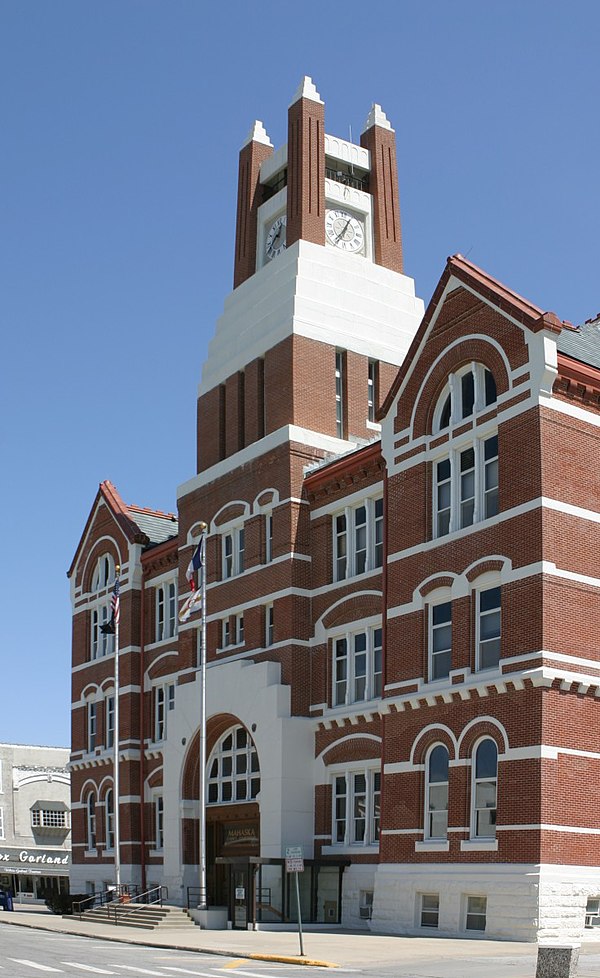Top Qs
Timeline
Chat
Perspective
Mahaska County, Iowa
County in Iowa, United States From Wikipedia, the free encyclopedia
Remove ads
Mahaska County is a county located in the U.S. state of Iowa. As of the 2020 census, the population was 22,190.[1] The county seat is Oskaloosa.[2]
Remove ads
Mahaska County comprises the Oskaloosa, IA Micropolitan Statistical Area.
Remove ads
History

Mahaska County was formed in February 1843. The county has been self-governing since February 5, 1844. It was named after Chief Mahaska of the Iowa people. The county was the first in Iowa to have a sheriff and a justice of peace.[3]
The first courthouse was completed in January 1846. When a larger structure was required, the second courthouse was constructed in 1885–86, first being used on February 27, 1886. The first school, a small log cabin one-half mile (ca. 2 km) east of Oskaloosa, was opened on September 16, 1844, and the Cumberland Presbyterian Church opened as the first church in 1846.[4] On July 2, 1850, the first edition of the Iowa Herald was issued (today the Oskaloosa Herald). The first tracks of the Des Moines Valley Railroad were laid through the county in 1864.[3]
Coal mining was once a major industry in Mahaska County.[5] During the 19th century, Muchakinock, about 5 miles (8.0 km) south of Oskaloosa, was probably the largest and most prosperous coal camp in Iowa.
Remove ads
Geography
According to the U.S. Census Bureau, the county has a total area of 573 square miles (1,480 km2), of which 571 square miles (1,480 km2) is land and 2.5 square miles (6.5 km2) (0.4%) is water.[6]
Major highways
Transit
Adjacent counties
- Jasper County (northwest)
- Poweshiek County (north)
- Keokuk County (east)
- Wapello County (southeast)
- Monroe County (southwest)
- Marion County (west)
Remove ads
Demographics
Summarize
Perspective

2020 census

The 2020 census recorded a population of 22,190 in the county, with a population density of 38.832/sq mi (14.993/km2). 96.02% of the population reported being of one race. 90.01% were non-Hispanic White, 1.78% were Black, 2.16% were Hispanic, 0.18% were Native American, 1.14% were Asian, 0.07% were Native Hawaiian or Pacific Islander and 4.66% were some other race or more than one race. There were 9,680 housing units, of which 8,799 were occupied.[1]
2010 census
The 2010 census recorded a population of 22,381 in the county, with a population density of 39.2051/sq mi (15.1372/km2). There were 9,766 housing units, of which 8,975 were occupied.[13]
2000 census
As of the census[14] of 2000, there were 22,335 people, 8,880 households, and 6,144 families residing in the county. The population density was 39 people per square mile (15 people/km2). There were 9,551 housing units at an average density of 17 units per square mile (6.6 units/km2). The racial makeup of the county was 97.20% White, 0.64% Black or African American, 0.19% Native American, 0.86% Asian, 0.03% Pacific Islander, 0.30% from other races, and 0.78% from two or more races. 0.85% of the population were Hispanic or Latino of any race.
There were 8,880 households, out of which 32.40% had children under the age of 18 living with them, 58.60% were married couples living together, 7.50% had a female householder with no husband present, and 30.80% were non-families. 26.60% of all households were made up of individuals, and 12.40% had someone living alone who was 65 years of age or older. The average household size was 2.45 and the average family size was 2.96.
In the county, the population was spread out, with 25.70% under the age of 18, 9.40% from 18 to 24, 26.80% from 25 to 44, 21.70% from 45 to 64, and 16.30% who were 65 years of age or older. The median age was 37 years. For every 100 females there were 99.10 males. For every 100 females age 18 and over, there were 96.90 males.
The median income for a household in the county was $37,314, and the median income for a family was $43,557. Males had a median income of $32,618 versus $23,192 for females. The per capita income for the county was $18,232. About 7.50% of families and 9.80% of the population were below the poverty line, including 11.70% of those under age 18 and 9.30% of those age 65 or over.
Remove ads
Communities
Cities
Unincorporated communities
Townships
Population ranking
The population ranking of the following table is based on the 2020 census of Mahaska County.[1]
† county seat
Remove ads
Politics
Summarize
Perspective
Mahaska County is a strongly Republican county. Only six Republican Party presidential candidates from 1880 to the present day have failed to win the county, most recently Barry Goldwater in 1964 in his landslide loss statewide & nationally to Lyndon B. Johnson.
Remove ads
See also
References
External links
Wikiwand - on
Seamless Wikipedia browsing. On steroids.
Remove ads



